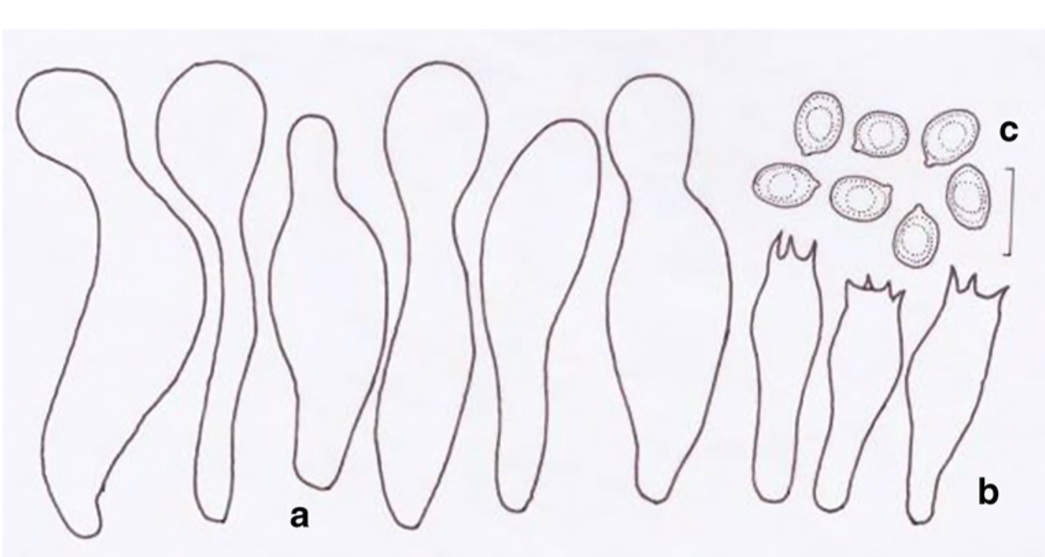Agaricus pseudolangei K.D. Hyde & R.L. Zhao
Index Fungorum number: IF551478 Facesoffungi number: FoF00985
Etymology: refers to the similarity to Agaricus langei in morphology
Holotype: BBH 19529 Pileus 6–8 cm diam., and 7–9 mm thick, hemisphaerical, convex, plano-convex, sometimes slightly depressed at the disc; surface heavily fibrillose, and breaking into scales towards the margin, light brown (6C3, 6B2). Lamellae free, crowded, lamellulae with 7 series, 4 mm broad, narrow to normal, white, dull red (8C3), brown, edge colour lighter than gill. Stipe 50–90×8–12 (base 14–16) mm, cylindrical to subbulbous, long clavate, smooth to silky, white. Annulus thick, rigid, pendent, white, entire, up to 12 mm broad. Odour mushroomy. Context firm, white, no staining on touching, strong scarlet staining on cutting. Macrochemical reaction: KOH reaction negative. Basidiospores 5.5–7×4.5–5.2 μm [x = 6.3±0.5×5±0.2, Q=1.1–1.4, n=20], ovoid to broad ellipsoid, brown, smooth. Basidia 21–26×7–9 μm, clavate, hyaline, smooth. Cheilocystidia present or disrupted in some basidiomata, 20–35×5–10 μm, ventricose-capitate, and some with an elongate neck, hyaline, smooth. Pleurocystidia absent. Pileipellis a cutis of hyphae of 7–15 μm diam., cylindrical, light brown, smooth. Annulus hyphae of 7–15 μm diam., cylindrical, hyaline, smooth.
Habitat and distribution: solitary or scattered in small group on soil with excrements next to a chicken coop. Known only from Thailand.
Material examined: THAILAND, Chiang Mai Province, Mae Taeng, Ban Mae Sae Village, on Highway 1095, near 50 km marker, N19°14. 599′ E98°39.456′, elevation 962 m., 3 June 2006, collector Ruilin Zhao, ZRL3012 (BBH 19529, holotype), (HMAS and SFSU, isotypes); Ibid., Ban Pha Deng Village, N 19°17.123′ E 98°44. 009′, elev. 900 m, 3 October 2005, collector Ruilin Zhao, ZRL2137 (BBH 19507, HMAS and SFSU); same location, 5 August 2005, collector Ruilin Zhao, ZRL2122 (BBH 19501, HMAS and SFSU).
Notes: The phylogenetic analysis shows that this new species is sister to the species, but did not allow us to classify these two red staining new species in any known sections containing species exhibiting such a trait (sections Agaricus, Bivelares, Brunneopicti, Chitonioides, Nigrobrunnescentes, and Sanguinolenti subsections Bohusia and Sylvatici). Samples ZRL3012 and ZRL2136 have been included into the phylogenetic analysis but not named in our previous study (Zhao et al. 2011), and the results showed they were clustered together and loosely related to A. bohusii Bon, which is a red discoloring species from section Sanguinolenti subsection Bohusia (Parra 2008). In present study these two species form a clade with same topology as before. Extensive sampling and DNA sequences from other genes will be necessary to know if this clade would belong to one of the sections listed above or represents a new section. This species is distinct by its strong blood red discolouring on cutting and capitate cheilocystidia. Compared with the red staining species from the sections listed above, the new species is morphologically highly similar to A. langei (F.H. Møller) F.H. Møller of the section Agaricus because both have light brown scales on the pileus, a pilleipellis that remains undisrupted at the disc, and similar sized spores. However, A. pseudolangei has capitate cheilocystidia, while those of A. langei are pyriform. Agaricus pseudolangei has wide ellipsoid spores, Qm=1.27, while A. langei has ellipsoid to elongate ellipsoid spores, Qm=1.67. In addition, the distance between the two species in the tree confirms that they are not phylogenetically closely related. In section Sanguinolenti, A. depauperatus (F.H. Møller) Pilátis (also has light brown squamules on the pileus), however, this species has larger basidiospores (7–9.6×4–6 μm) than those of A. pseudolangei, and its pyriform cheilocystidia also differ from those of A. pseudolangei. This new species also similar to A. benesii (Pilát) Pilát and A. sylvaticus Schaeff which both exhibit a strong reddish discoloring on cutting and can have a light brown or even a pure white cap (Parra 2008), however these known species have clavate cheilocystidia with 1–2 septa at base which is completely different from the new species.


